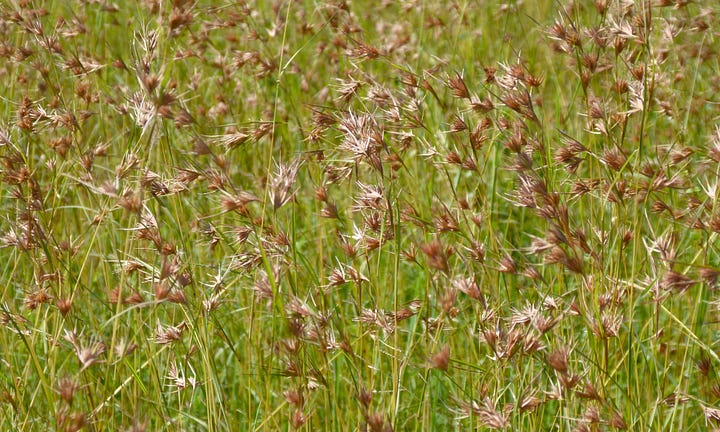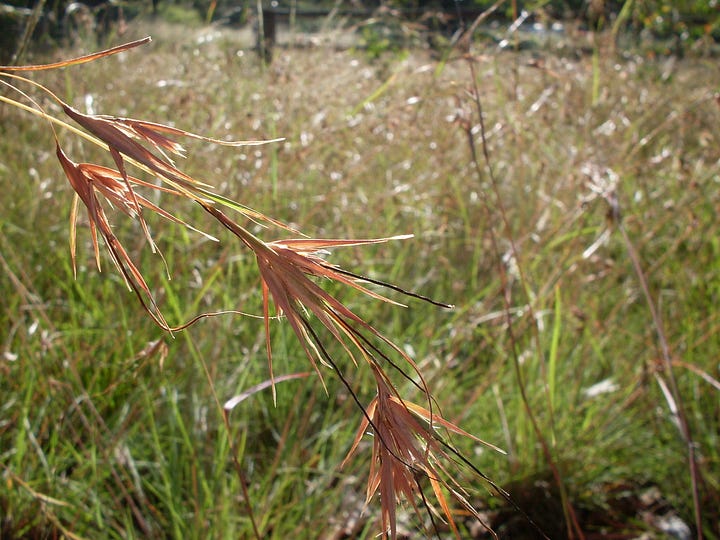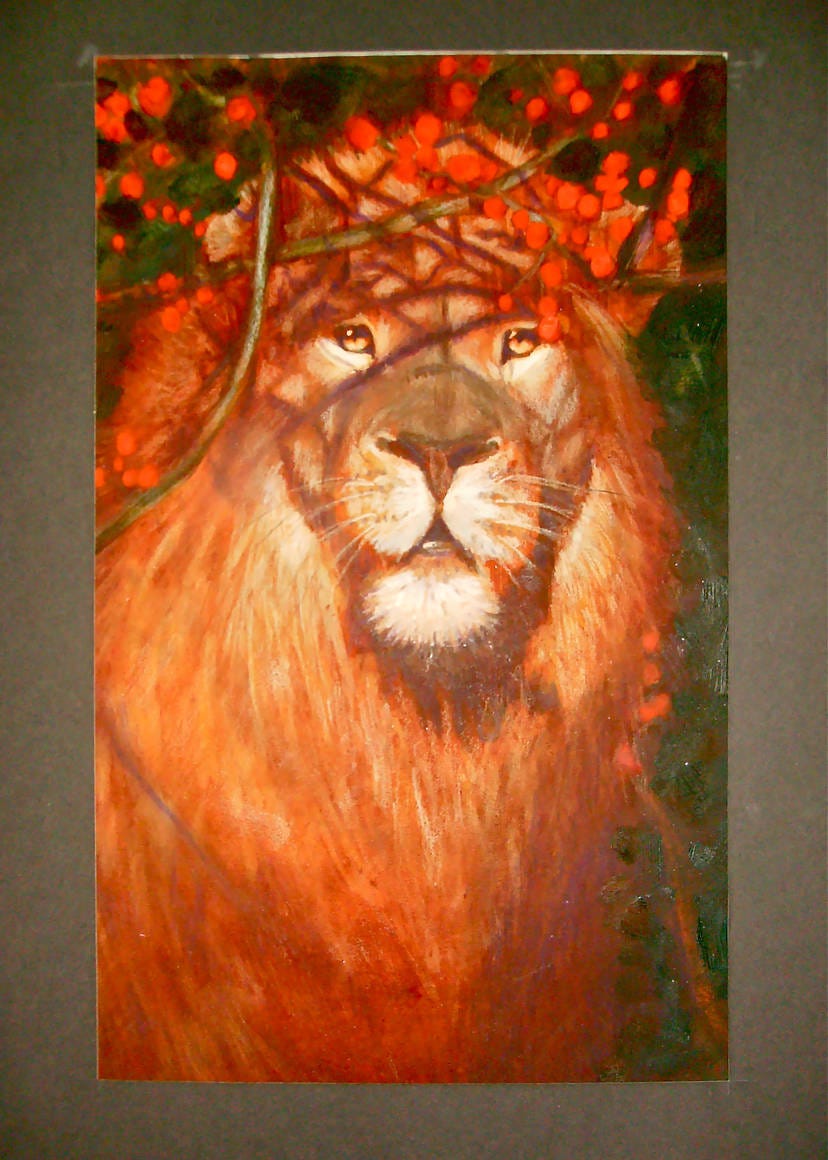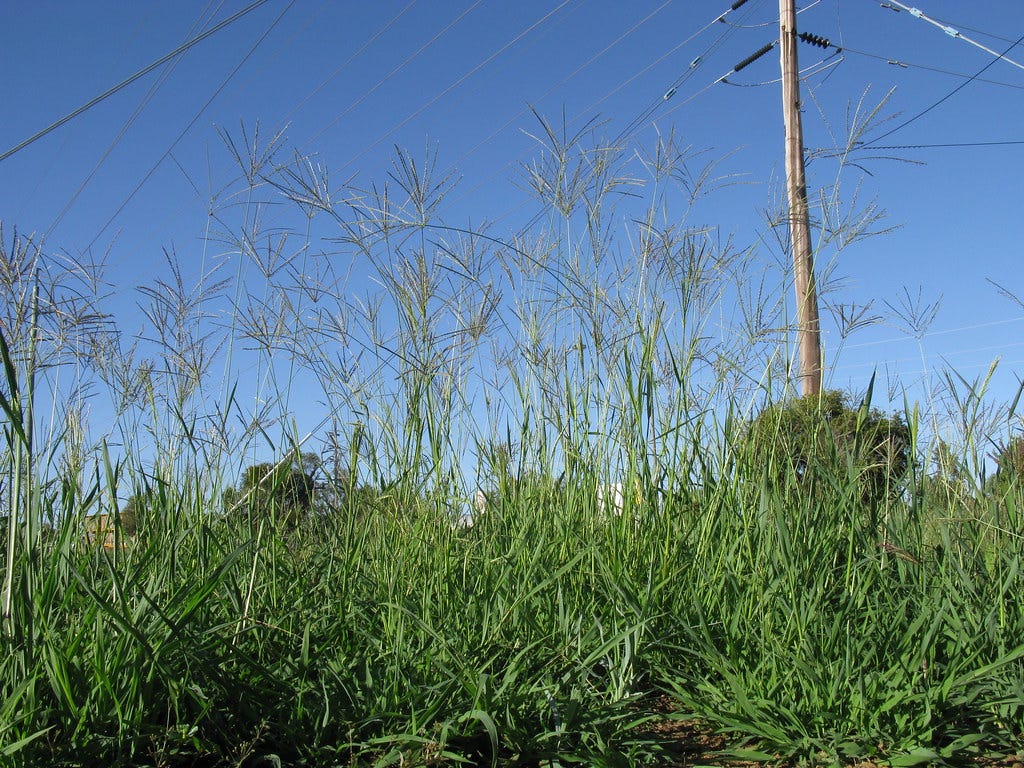ALSO KNOWN AS: Themeda triandra, kangaroo grass, rooigras, rejaculue, chindindi, tlhógokgólwané
How to know
A greenblue grass that becomes red as it goes to seed
Inflorescences that have long tufts
The heavy seeds make the whole plant seem to swoop down in an arc
Long spathes, or leaves that extend toward the sky


Africa is believed to be 4 billion years older than Eurasia or North America. It has been in contact with the winds for all this time. So, while it is laced with rivers and cooled by giant lakes, rippling with ancient lava flows, it is shaped primarily by air, sun. The land from the top of the continent to the bottom has undergone so many climatic transformations, and yet it has remained, all this time, in the air so those species that have developed on it have learned to work with these elements with true mastery.
King of Hot Grasslands
Red oat grass longs for full sun and thick clay soil - with only touches of sand here or there. Clay soil is deadly to many plants, binding nutrients, and becoming easily waterlogged, which suffocates and stagnates root growth. But red oat grass doesn’t mind the water or the compact soil, it just wants that dry heat. And not only does it like the dry heat. It makes it. Red oat grass plunges its roots into the soil, storing water, drying what might be a wet water table and managing the salinity in the soil, which maintains the health of all the plants around who can’t live with too much salt.
There are less than thirty species of Themeda grasses, and they extend across a wide range of fields, spanning Afghanistan to Australia. Much of the grasslands in Africa from the Serengeti to the Cape are red oat grass, along with good portions of Australia’s grasslands. It is the source of food for a network of foragers and grazers who roam this equatorial range.
Part of the vast Poaceae, or grass, family, the one that nets the open earth on marshlands and drylands alike. This particular grass is related to sorghum, lemongrass, and corn. This tribe of grasses may have adapted during several climate events around the Late Miocene era, a period which heightened carbon dioxide and forced a tribe of grasses to step up their photosynthetic intake. Some developed a third chromosome and many lengthened their leaves. A new kind of grassland began to manifest in the warm climates of the world and grazers began to exist. All of this is a vague story written in the genetics of Themeda and its relatives. But over and over again we find how all of time is written in the DNA of life.
The presence of red oat grass signifies a healthy grassland. This is called “good veld condition”, grasses that support and sustain life, while working as a net to gently hold the soil together. They protect against erosion, and burn when they need to, making way for other plants to grow, and awakening their dormant seeds as the flames pass through.
Red oat grass is identified by its distinctive inflorescence and seedhead. The grasses grow together in bunches which are called tussocks, huddled together rather than spanning an entire field like other grasses might - like blue and Bermuda grass. Some of this adaptation may have to do with how much water is present. The more water there is the more like a button these tussocks are, the less water, the more they spread out. The grasses extend up to three feet high and along their stem shoots sheaths of narrow leaves that end in sharp points. But their flowers bow down. These flower structures look like upturned crowns. They are heavy and bare the grasses down. Long modified leaves called awns are attached to the lemmas, or seedpods. Theses awns look like downward facing sun rays. A seed is long for a herbaceous plant, they are the length of a child’s pinky, from the end to the distal to the top. One joint’s worth.
These provide the ray look that makes them so unique. These awns that bristle with tiny hairs. They are not meant to reach toward heaven though, they are meant to dig into the earth and ensure a stable base where the seed can begin to germinate. The extra help the awns bring sustainability to a plant that doesn’t produce many seeds to begin with. They pollinate by wind, bloom from October through July and their seed germinate in the rainy season in February and March. But the fire is the key to their survival, sustainability and seed germination.
From Water to Fire: A Landscape Painter
When the plants age they turn from a greenish blue, to an earthen red that perfectly matches the tone and the fluffed texture of the lion’s mane.
While they are cover for the predator, they are veil for the prey. Red oat grass is the perfect height for kangaroos who hide in their sand-colored veils and eat their ripe seeds.
Their lovely tonal shift from turquoise to red mimics a transition that happens in these periodically dry environments as well. As with many grasslands, these plants are adapted to fires. Red oat grass is usually the first to come up after a fire. Their movement also reflects a fire. They jump like boisterous puppets jumping on green threads. They look like cubism come to life, they are the geometric chaos of futurist paintings, only they go nowhere, but listen to the winds and remember the fire. Memory does seem to be an important factor for the survival of this species because the more fires there are the more resistant this grass becomes.
If we are to give numbers to this grass of countless years and influence, It might go something like this: they can survive 100 years under proper management. They require a cool, smoldering, fire every five-to-ten years. Triandra refers to the three male spikelets surrounding the interior female spikelets for each flower. There are probably more, but the range and number of this species might be enough for a god to count, or generations of dedicated humans. They built many parts of this ancient land mass and numbers stretch to fill that story.
Red oat grass has been used as food to humans as well as animals, throughout the regions where it is native. In Australia, aboriginal communities made bread, called damper, which is a type of soda bread out of the flour. Damper is made by wrapping the dough around a stick and cooking it over a fire, like bready marshmallows or hotdogs. In western Africa the roots have been used as a medicine. Pulp from the fibers has been made into paper and its stems have been woven into thatching and baskets.
Myth for red oat grass
Forager Friendly?
Yes! Harvest with care!
Not to be confused with common finger grass. These are common on the savanna. But they don’t have the red shock of a seed head. They are long and smooth with wisps of inflorescences.
Or the straw-colored flatsedge that has big crown-like inflorescences, but they are yellowed, and flowers grow like rays from an upright stem. These plants are also generally in more damp soils.
Sources
https://courses.pdp.albany.edu/courses/HSposttest/mainMenu.cfm
https://pza.sanbi.org/themeda-triandra
https://www.sciencedirect.com/topics/agricultural-and-biological-sciences/andropogoneae
https://www.leafconagro.com/red-oat-grass/
https://garden.org/plants/view/117049/Red-Oat-Grass-Themeda-triandra/
https://www.youtube.com/watch?v=0v1eeYBqe7c
https://www.science.org/doi/10.1126/science.1177216
https://www.youtube.com/watch?v=4YtPvWsO5oQ
https://www.botswanaflora.com/speciesdata/species.php?species_id=109100
https://www.youtube.com/watch?v=M-xmcqnntMs
https://evolution.earthathome.org/grasses/andropogoneae/kangaroo-grass-quick-facts/
https://tsammalex.clld.org/parameters/themedatriandra
https://talk.snapshotserengeti.org/boards/BSG000000b/discussions/DSG0001k7d






